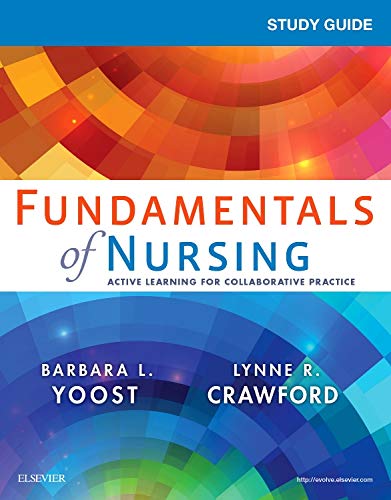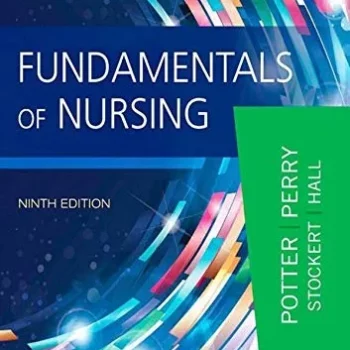Fundamentals Nursing Active Learning 1st Edition Yoost Crawford – Test Bank
Original price was: $55.00.$22.00Current price is: $22.00.
Digital item No Waiting Time Instant Download
ISBN-10: 0323358535 ISBN-13: 978-0323358538
Publisher : Mosby; 1st edition
Authors: Barbara L Yoost MSN RN CNE ANEF,
Lynne R Crawford MSN MBA RN CNE,
Patricia Castaldi DNP RN
Description
Fundamentals Nursing Active Learning 1st Edition Yoost Crawford – Test Bank
MULTIPLE CHOICE
1. Enduring ideas about what a person considers is desirable or has worth in life is known as a:
|
a. |
value. |
|
b. |
first-order belief |
|
c. |
higher order belief |
|
d. |
stereotype |
ANS: A
Values are enduring ideas about what a person considers is the good, the best, and the “right” thing to do and their opposites—the bad, worst, and wrong things to do—and about what is desirable or has worth in life. First-order beliefs serve as the foundation or the basis of an individual’s belief system. Higher-order beliefs are ideas derived from a person’s first-order beliefs, inductive, or syllogistic reasoning. A stereotype is a belief about a person, a group, or an event that is thought to be typical of all others in that category.
DIF: Remembering REF: pp. 22-23 OBJ: 2.1
TOP:Assessment
MSC: NCLEX Client Needs Category: Safe and Effective Care Environment: Management of Care
NOT: Concepts: Professionalism
2. A group of students are discussing the history of nursing. A student states, “Yea, nurses used to be called the doctor’s handmaiden.” This type of comment is known as a:
|
a. |
prejudice. |
|
b. |
generalization. |
|
c. |
stereotype. |
|
d. |
belief. |
ANS: C
A stereotype is a belief about a person, a group, or an event that is thought to be typical of all others in that category. A prejudice is a preformed opinion, usually an unfavorable one, about an entire group of people that is based on insufficient knowledge, irrational feelings, or inaccurate stereotypes. In the process of learning, people form generalizations (general statements or ideas about people or things) to relate new information to what is already known and to categorize the new information, making it easier to remember or understand. A belief is a mental representation of reality or a person’s perceptions about what is right (correct), true, or real, or what the person expects to happen in a given situation.
DIF: Understanding REF: pp. 22-23 OBJ: 2.2
TOP:Evaluation
MSC: NCLEX Client Needs Category: Safe and Effective Care Environment: Management of Care
NOT: Concepts: Professionalism
3. A values system is a set of somewhat consistent values and measures that are organized hierarchically into a belief system on a continuum of relative importance. A value system is also:
|
a. |
culturally based. |
|
b. |
unique to each individual. |
|
c. |
a poor basis for making decisions. |
|
d. |
rigid and uniform within a culture. |
ANS: A
Anthropologists and social scientists have noted that in every culture, a particular value system prevails and consists of culturally defined moral and ethical principles and rules that are learned in childhood. Each individual possesses a relatively small number of values and may share the same values with others, but to different degrees. A value system helps the person choose between alternatives, resolve values conflicts, and make decisions. Within every culture, however, values vary widely among subcultural groups and even between individuals on the basis of the person’s gender, personal experiences, personality, education, and many other variables.
DIF: Remembering REF: pp. 23-24 OBJ: 2.1
TOP: Assessment MSC: NCLEX Client Needs Category: Psychosocial Integrity
NOT: Concepts: Professionalism
4. The nurse is caring for a patient who is under arrest for murder. She is attempting to perform her duties while, at the same time, feeling a sense of repugnance toward the patient. The nurse is undergoing:
|
a. |
value clarification |
|
b. |
value conflict |
|
c. |
first-order beliefs |
|
d. |
higher-order beliefs |
ANS: B
A values conflict occurs when a person’s values are inconsistent with his or her behaviors or when the person’s values are not consistent with the choices that are available. Providing care for a convicted murderer may elicit troubling feelings for a nurse, resulting in a values conflict between the nurse’s commitment to care for all people and a personal repugnance for the act of murder. First-order beliefs serve as the foundation or the basis of an individual’s belief system. Higher-order beliefs are ideas derived from a person’s first-order beliefs, inductive, or syllogistic reasoning.
DIF: Understanding REF: pp. 22-24 OBJ: 2.2
TOP: Diagnosis MSC: NCLEX Client Needs Category: Psychosocial Integrity
NOT: Concepts: Professionalism
5. While helping patients with values clarification and care decisions, nurses should:
|
a. |
convince the patient to do what the nurse believes is best. |
|
b. |
give advice about what the nurse would do. |
|
c. |
tell the patient what the right thing to do is. |
|
d. |
provide information so that the patient can make informed decisions. |
ANS: D
While helping patients with values clarification and care decisions, nurses must be aware of the potential influence of their professional nursing role on patient decision making. Nurses should be careful to assist patients to clarify their own values in reaching informed decisions. Providing information to patients so that they can make informed decisions is a critical nursing role. Giving advice or telling patients what to do in difficult circumstances is both unethical and ill-advised.
DIF: Applying REF: p. 25 OBJ: 2.2 TOP: Implementation
MSC: NCLEX Client Needs Category: Psychosocial Integrity NOT: Concepts: Professionalism
6. A patient with terminal cancer says to the nurse, “I just don’t know if I should allow CPR in the event I quit breathing. What do you think?” Which statement by the nurse would be most beneficial to the patient?
|
a. |
“If it were me, I would want to live no matter what.” |
|
b. |
“Don’t worry. You have plenty of time to decide that later on.” |
|
c. |
“It’s totally up to you. Have you discussed this with your family?” |
|
d. |
“Let’s talk about what CPR means to you.” |
ANS: D
The use of the value clarification process is helpful when assisting patients in making health care decisions regarding end-of-life care. Giving advice or telling patients what to do is unethical and not recommended. Ignoring a patient concern or changing the subject is inappropriate. Patients should be given factual information in order for them to make their own decisions.
DIF: Applying REF: pp. 24-25 OBJ: 2.3 TOP: Implementation
MSC: NCLEX Client Needs Category: Psychosocial Integrity NOT: Concepts: Professionalism
7. The nurse is observed sitting at the bedside of a patient discussing the nursing care plan for the shift. Which theory or model most accurately reflects this nurse–patient relationship?
|
a. |
Swanson’s Theory of Caring |
|
b. |
Travelbee’s Human-to-Human Relationship Model |
|
c. |
Watson’s Theory of Caring |
|
d. |
Leininger Cultural Care Theory |
ANS: A
Swanson’s five caring processes include being with and enabling. Sitting at the bedside and sharing information are activities that exemplify these behaviors. Travelbee’s model describes steps toward compassionate and empathetic care. Watson’s theory of caring impacts both the person and the universe and is built upon 10 carative factors. Leininger describes patient care and its relationship to cultural diversity.
DIF: Understanding REF: pp. 27-28 OBJ: 2.5
TOP: Diagnosis MSC: NCLEX Client Needs Category: Psychosocial Integrity
NOT: Concepts: Professionalism
8. The student nurse is planning care for a patient who believes that Western medicine is effective but not always accurate. Nursing theory would best explain the patient’s health practices?
|
a. |
Nursing: Human Science and Human Care |
|
b. |
Cultural Care Theory |
|
c. |
Human-to-Human Relationship Model |
|
d. |
Five Caring Processes |
ANS: B
Leininger describes patient care and its relationship to cultural diversity. Swanson’s five caring processes include maintaining belief, knowing, being with, doing for, and enabling. Travelbee’s Human-to-Human Relationship Model describes steps toward compassionate and empathetic care. Watson’s theory of Human Science and Human Care impacts both the person and the universe and is built upon 10 carative factors.
DIF: Understanding REF: pp. 27-28 OBJ: 2.5
TOP: Diagnosis MSC: NCLEX Client Needs Category: Psychosocial Integrity
NOT: Concepts: Professionalism
9. Which nursing theorist describes the nurse–patient relationship as interpersonal with a focus on compassion and empathy?
|
a. |
Kristen Swanson |
|
b. |
Jean Watson |
|
c. |
Madeleine Leininger |
|
d. |
Joyce Travelbee |
ANS: D
Travelbee’s Human-to-Human Relationship Model describes steps toward compassionate and empathetic care. Leininger describes patient care and its relationship to cultural diversity. Swanson’s five caring processes include maintaining belief, knowing, being with, doing for, and enabling. Watson’s theory of Human Science and Human Care impacts both the person and the universe and is built upon 10 carative factors.
DIF: Remembering REF: pp. 27-28 OBJ: 2.5
TOP: Assessment MSC: NCLEX Client Needs Category: Psychosocial Integrity
NOT: Concepts: Professionalism
10. The nurse on a busy medical–surgical floor contacts a social worker requesting a home care referral prior to a patient’s discharge. This action is best illustrated by which of Swanson’s Five Caring Processes?
|
a. |
Enabling |
|
b. |
Knowing |
|
c. |
Doing For |
|
d. |
Being with |
|
e. |
Maintaining Belief |
ANS: A
Advocating for a patient’s post-hospitalization care is an enabling process. Enabling also includes informing, anticipating, and preparing for the future. Swanson’s Five Caring Processes also include maintaining belief, knowing, being with, and doing for.
DIF: Remembering REF: p. 28 OBJ: 2.5
TOP: Assessment MSC: NCLEX Client Needs Category: Psychosocial Integrity
NOT: Concepts: Professionalism





Be the first to review “Fundamentals Nursing Active Learning 1st Edition Yoost Crawford – Test Bank”